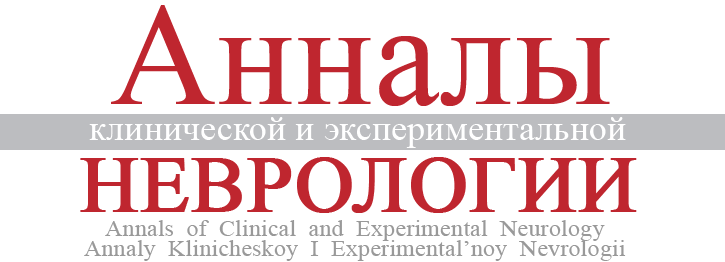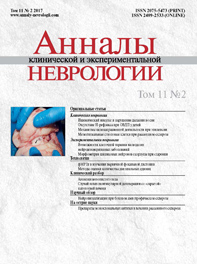Возможности метода функциональной магнитно-резонансной томографии покоя в изучении патофизиологии первичной фокальной дистонии
- Авторы: Семенова О.В.1, Тимербаева С.Л.1, Коновалов Р.Н.1
-
Учреждения:
- ФГБНУ «Научный центр неврологии»
- Выпуск: Том 11, № 2 (2017)
- Страницы: 48-54
- Раздел: Технологии
- Дата подачи: 06.08.2017
- Дата публикации: 06.08.2017
- URL: https://annaly-nevrologii.com/journal/pathID/article/view/476
- DOI: https://doi.org/10.18454/ACEN.2017.2.7
- ID: 476
Цитировать
Полный текст
Аннотация
Функциональная магнитно-резонансная томография покоя (фМРТп) оценивает состояние низкочастотных колебаний BOLD-сигнала, отражающих спонтанную нейрональную активность различных отделов головного мозга. Таким образом, фМРТп позволяет визуализировать синхронность генерации определенных нейрофизиологических феноменов со стороны различных, в том числе удаленных друг от друга, отделов центральной нервной системы, связывая их в функциональные сети и оценивая коннективность мозга в норме и при патологии. Данная методика хорошо проявила себя при изучении нейродегенеративных заболеваний. В настоящем обзоре представлены результаты применения фМРТп при наиболее распространенных формах первичной фокальной дистонии (блефароспазм, цервикальная дистония), в сопоставлении с данными нагрузочной фМРТ и некоторых других технологий нейровизуализации (позитронно-эмиссионная томография, воксел-ориентированная морфометрия). В большом числе исследований показано, что фМРТп позволяет оценить нарушения церебральной архитектуры и сложные нейросетевые перестройки у больных с фокальными дистониями, в том числе на фоне применения ботулинического токсина. Это способствует более глубокому изучению патофизиологических основ фокальных дистоний и многообразных механизмов ботулинотерапии при данных заболеваниях, включая центральные (непрямые) механизмы действия ботулотоксина.
Об авторах
Ольга В. Семенова
ФГБНУ «Научный центр неврологии»
Автор, ответственный за переписку.
Email: semenovaov@me.com
Россия, Москва
София Л. Тимербаева
ФГБНУ «Научный центр неврологии»
Email: semenovaov@me.com
Россия, Москва
Родион Николаевич Коновалов
ФГБНУ «Научный центр неврологии»
Email: semenovaov@me.com
ORCID iD: 0000-0001-5539-245X
к.м.н., с.н.с. отд. лучевой диагностики
Россия, 125367, Москва, Волоколамское шоссе, д. 80Список литературы
- Marsden C.D., Quinn N.P. The dystonias. BMJ: British Medical Journal. 1990;300(6718):139. PMID: 2105790.
- Defazio G. The epidemiology of primary dystonia: current evidence and perspectives. European journal of neurology. 2010; 17(s1): 9-14. PMID: 20590802. doi: 10.1111/j.1468-1331.2010.03053.x.
- Epidemiological Study of Dystonia in Europe Collaborative G. A prevalence study of primary dystonia in eight European countries. Journal of neurology. 2000; 247(10): 787-92. PMID: 11127535.
- Kuyper D.J., Parra V., Aerts S. et al. Nonmotor manifestations of dystonia: a systematic review. Movement Disorders. 2011; 26(7): 1206-17. PMID: 21484874. doi: 10.1002/mds.23709.
- Albanese A., Asmus F., Bhatia K.P. et al. EFNS guidelines on diagnosis and treatment of primary dystonias. European Journal of Neurology. 2011; 18(1): 5-18. PMID: 20482602. doi: 10.1111/j.1468-1331.2010.03042.x.
- Phukan J., Albanese A., Gasser T., Warner T. Primary dystonia and dystonia-plus syndromes: clinical characteristics, diagnosis, and pathogenesis. The Lancet Neurology. 2011; 10(12): 1074-85. PMID: 22030388. doi: 10.1016/S1474-4422(11)70232-0.
- Camfield L., Ben‐Shlomo Y., Warner T.T. Impact of cervical dystonia on quality of life. Movement disorders. 2002; 17(4): 838-41. PMID: 12210891. doi: 10.1002/mds.10127
- Albanese A. The clinical expression of primary dystonia. Journal of neurology. 2003;250(10):1145-51. PMID: 14586593. doi: 10.1007/s00415-003-0236-8.
- Nicoletti A., Aoki L., Nahas T.R., Matayoshi S. Essential blepharospasm: literature review. Arquivos brasileiros de oftalmologia. 2010; 73(5): 469-73. PMID: 21225137.
- Timerbaeva S.L. [Role of model neuroimaging in the studies of focal distonia]. Annals of Clinical and Experimental Neurology. 2012; 6(2): 48-54 (in Russ.).
- Gordon N.S. Focal dystonia, with special reference to writer's cramp. International journal of clinical practice. 2005; 59(9): 1088-90. PMID: 16115186. doi: 10.1111/j.1742-1241.2005.00603.x.
- Rhoad R.C., Stern P.J. Writer's cramp—a focal dystonia: etiology, diagnosis, and treatment. The Journal of hand surgery. 1993; 18(3): 541-4. PMID: 8515033. doi: 10.1016/0363-5023(93)90109-G.
- Hallett M., Evinger C., Jankovic J., Stacy M. Update on blepharospasm Report from the BEBRF International Workshop. Neurology. 2008;71(16):1275-82. PMID: 18852443. doi: 10.1212/01.wnl.0000327601.46315.85.
- Krasnov М.Yu., Timerbaeva S.L., Illarioshkin S.N. [Genetics of hereditary forms of dystonia]. Annals of Clinical and Experimental Neurology. 2013; 7(2): 55-60 (in Russ.).
- Delmaire C., Vidailhet M., Elbaz A. et al. Structural abnormalities in the cerebellum and sensorimotor circuit in writer's cramp. Neurology. 2007;69(4):376-80. PMID: 17646630. doi: 10.1212/01.wnl.0000266591.49624.1a.
- Draganski B., Thun-Hohenstein C., Bogdahn U. et al. “Motor circuit” gray matter changes in idiopathic cervical dystonia. Neurology. 2003; 61(9): 1228-31. PMID: 14610125.
- Egger K., Mueller J., Schocke M. et al. Voxel based morphometry reveals specific gray matter changes in primary dystonia. Movement Disorders. 2007; 22(11): 1538-42. PMID: 17588241. doi: 10.1002/mds.21619.
- Schmidt K.E., Linden D., Goebel R. et al. Striatal activation during blepharospasm revealed by fMRI. Neurology. 2003;60(11):1738-43. PMID: 12796523.
- Zoons E., Booij J., Nederveen A.J. et al. Structural, functional and molecular imaging of the brain in primary focal dystonia—a review. Neuroimage. PMID: 21349339. doi: 10.1016/j.neuroimage.2011.02.045 2011;56(3):1011-20.
- Timerbaeva S.L. Fokal'nye i segmentarnye formy pervichnoy distonii: klinicheskie, patofiziologicheskie i molekulyarno-geneticheskie aspekty: dis... dokt. med. nauk [Focal and segmental forms of primary dystonia: clinical, pathophysiological and molecular-genetic aspects. D.Sci (Med.) diss.]. Moscow. 2012: 232 p. (in Russ.).
- Suzuki Y., Mizoguchi S., Kiyosawa M. et al. Glucose hypermetabolism in the thalamus of patients with essential blepharospasm. Journal of neurology. 2007; 254(7): 890-6. PMID: 17325818. doi: 10.1007/s00415-006-0468-5.
- Kerrison J.B., Lancaster J.L., Zamarripa F.E. et al. Positron emission tomography scanning in essential blepharospasm. American journal of ophthalmology. 2003; 136(5): 846-52. PMID: 14597035.
- Singer C., Velickovic M. Cervical dystonia: etiology and pathophysiology. Neurologic clinics. 2008; 26: 9-22. PMID: 18603165.
- Velickovic M., Benabou R., Brin M.F. Cervical dystonia. Drugs. 2001; 61(13): 1921-43. PMID: 11708764.
- Eidelberg D., Moeller J.R., Ishikawa T. et al. The metabolic topography of idiopathic torsion dystonia. Brain. 1995; 118(6): 1473-84. PMID: 8595478.
- Garraux G., Bauer A., Hanakawa T. et al. Changes in brain anatomy in focal hand dystonia. Annals of neurology. 2004; 55(5): 736-9. PMID: 15122716. doi: 10.1002/ana.20113.
- Obermann M., Yaldizli O., De Greiff A. et al. Morphometric changes of sensorimotor structures in focal dystonia. Movement disorders. 2007; 22(8): 1117-23. PMID: 17443700. doi: 10.1002/mds.21495.
- Pantano P., Totaro P., Fabbrini G. et al. A transverse and longitudinal MR imaging voxel-based morphometry study in patients with primary cervical dystonia. American journal of neuroradiology. 2011; 32(1): 81-4. PMID: 20947646. doi: 10.3174/ajnr.A2242.
- Dresel C., Li Y., Wilzeck V. et al. Multiple changes of functional connectivity between sensorimotor areas in focal hand dystonia. Journal of Neurology, Neurosurgery & Psychiatry. 2014; 85(11): 1245-52. PMID: 24706945. doi: 10.1136/jnnp-2013-307127.
- Hu X-Y., Wang L., Liu H., Zhang S-Z. Functional magnetic resonance imaging study of writer's cramp. Chinese medical journal. 2006;119(15):1263-71. PMID: 16919185.
- Oga T., Honda M., Toma K. et al. Abnormal cortical mechanisms of voluntary muscle relaxation in patients with writer’s cramp: an fMRI study. Brain. 2002; 125(4): 895-903. PMID: 11912121.
- Baker R.S., Andersen A.H., Morecraft R.J., Smith C.D. A functional magnetic resonance imaging study in patients with benign essential blepharospasm. Journal of neuro-ophthalmology. 2003; 23(1): 11-5. PMID: 12616082.
- Timerbaeva S.L., Konovalov R.N., Illarioshkin S.N. [Focal dystonia: mapping of cerebral motor zones with functional MRI]. Nevrologicheskiy zhurnal. 2012; 17(3): 23-29 (in Russ.).
- Opavský R., Hluštík P., Otruba P., Kaňovský P. Sensorimotor network in cervical dystonia and the effect of botulinum toxin treatment: a functional MRI study. Journal of the neurological sciences. 2011;306(1):71-5. PMID: 21492880. doi: 10.1016/j.jns.2011.03.040.
- Løkkegaard A., Herz D.M., Haagensen B.N. et al. Altered sensorimotor activation patterns in idiopathic dystonia—an activation likelihood estimation meta‐analysis of functional brain imaging studies. Human brain mapping. 2016; 37(2): 547-57. PMID: 26549606. doi: 10.1002/hbm.23050.
- Lee M.H., Smyser C.D., Shimony J.S. Resting-state fMRI: a review of methods and clinical applications. American Journal of Neuroradiology. 2013; 34(10): 1866-72. PMID: 22936095. doi: 10.3174/ajnr.A3263.
- Seliverstova E.V., Seliverstov Yu.A., Konovalov R.N., Illarioshkin S.N. [Resting-state fMRI: new possibilities for studying physiology and pathology of the brain]. Annals of Clinical and Experimental Neurology. 2013; 7(4): 39-44 (in Russ.).
- Delnooz C.S., Helmich R.C., Toni I., van de Warrenburg B. Reduced parietal connectivity with a premotor writing area in writer's cramp. Movement Disorders. 2012; 27(11): 1425-31. PMID: 22886735. doi: 10.1002/mds.25029.
- Delnooz C.S., Pasman J.W., Beckmann C.F., van de Warrenburg B. Task-free functional MRI in cervical dystonia reveals multi-network changes that partially normalize with botulinum toxin. PloS one. 2013; 8(5): e62877. PMID: 23650536. doi: 10.1371/journal.pone.0062877.
- Delnooz C.S., Pasman J.W., Beckmann C.F., van de Warrenburg B. Altered striatal and pallidal connectivity in cervical dystonia. Brain Structure and Function. 2015; 220(1): 513-23. PMID: 24259114. doi: 10.1007/s00429-013-0671-y.
- Yang J., Luo C., Song W. et al. Altered regional spontaneous neuronal activity in blepharospasm: a resting state fMRI study. Journal of neurology. 2013; 260(11): 2754-60. PMID: 23900755. doi: 10.1007/s00415-013-7042-8.
- Zhou B., Wang J., Huang Y. et al. A resting state functional magnetic resonance imaging study of patients with benign essential blepharospasm. Journal of Neuro-Ophthalmology. 2013; 33(3): 235-40. PMID: 23636105. doi: 10.1097/WNO.0b013e31828f69e5.
- Hinkley L.B., Sekihara K., Owen J.P. et al. Complex-value coherence mapping reveals novel abnormal resting-state functional connectivity networks in task-specific focal hand dystonia. Frontiers in neurology. 2013; 4: 149. PMID: 24133480. doi: 10.3389/fneur.2013.00149.
- Mohammadi B., Kollewe K., Samii A. et al. Changes in resting‐state brain networks in writer's cramp. Human brain mapping. 2012; 33(4): 840-8. PMID: 21484954. doi: 10.1002/hbm.21250.
- Battistella G., Termsarasab P., Ramdhani R.A. et al. Isolated focal dystonia as a disorder of large-scale functional networks. Cerebral Cortex. 2017; 27(2): 1203-1215. PMID: 26679193. doi: 10.1093/cercor/bhv313.
- Battistella G., Fuertinger S., Fleysher L. et al. Cortical sensorimotor alterations classify clinical phenotype and putative genotype of spasmodic dysphonia. European journal of neurology. 2016; 23(10): 1517-27. PMID: 27346568. doi: 10.1111/ene.13067.
- Camargo C., Cattai L., Teive H. Pain relief in cervical dystonia with botulinum toxin treatment. Toxins. 2015; 7(6): 2321-35. PMID: 26110508. doi: 10.3390/toxins7062321.
- Colosimo C., Tiple D., Berardelli A. Efficacy and safety of long-term botulinum toxin treatment in craniocervical dystonia: a systematic review. Neurotoxicity research. 2012; 22(4): 265-73. PMID: 22359151. doi: 10.1007/s12640-012-9314-y.
- Horwath-Winter J., Bergloeff J., Floegel I. et al. Botulinum toxin A treatment in patients suffering from blepharospasm and dry eye. British journal of ophthalmology. 2003; 87(1): 54-6. PMID: 12488263.
- Mills R.R., Pagan F.L. Patient considerations in the treatment of cervical dystonia: focus on botulinum toxin type A. Patient preference and adherence. 2015;9:725. PMID: 26082621. doi: 10.2147/PPA.S75459.
- Ramirez-Castaneda J., Jankovic J. Long-term efficacy and safety of botulinum toxin injections in dystonia. Toxins. 2013; 5(2): 249-66. PMID: 23381141. doi: 10.3390/toxins5020249.
- Timerbaeva S.L., Ivanova-Smolenskaya I.A., Markova E.D. et al. [Botulinum toxin-A is a highly effective treatment for focal dystonias]. Zhurnal nevrologii i psikhiatrii im. S.S. Korsakova. 2000; (5): 32-5 (in Russ.).
- Nevrly M., Hlustik P., Otruba P. et al. Changes in sensorimotor network activations after botulinum toxin type a injections in patients with cervical dystonia. A functional MRI study. Parkinsonism & Related Disorders. 2012; 18: 71. DOI: http://dx.doi.org/10.1016/S1353-8020(11)70356-X.
Дополнительные файлы








